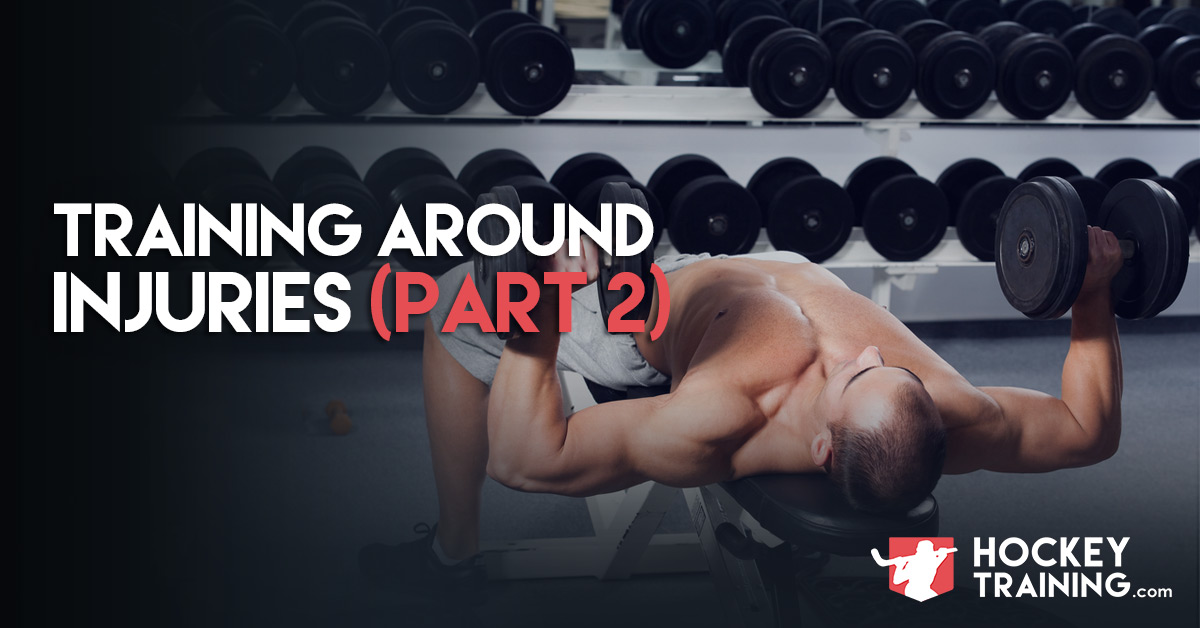In this article, I’m going to show you the best ways you can work around the most common hockey injuries so that no matter what happens you’re always going to become a better hockey player!
The idea for this article was suggested to me quite a while back but it can be a tough one to tackle in an online setting because you have no context or client-history to work with.
Because of this barrier, I thought a great route to take would be to split it up into different sections.
First let’s talk about some of the more common injury recovery strategies that people use on everything, how they work, and where they actually stand on the effectiveness scale.
Such things would include:
• Non-Steroidal Anti-inflammatory Drugs (NSAIDs)
• Wraps
• Tape
• Sleeves
• Braces
• Ice vs. heat
• Stretching
After giving a quick rundown on each of those, we’ll use both this article and Part 2 to arm you with the strategy you need to move forward with.
But first, there’s two things I really want to preface every single statement I make within this two-part article series.
#1: Lots of times, just simply not being a reckless will solve your problem. Now you might ask yourself, “Well what do reckless people do?” I’ll tell you. Reckless people do the following:
- They sacrifice good technique for more weight on the bar. You’re just asking for an injury here. More weight plus poor technique will always be a recipe for disaster.
- They never actually learned good technique from a qualified strength coach but perform complex lifts with lots of weight. For example, the bench press, squat and deadlift are all much more complex than they look.
- They injure themselves on a certain lift, and then never stop doing that lift and wonder why they aren’t healing. For example, if you hurt your shoulder for whatever reason on the bench press and then keep continuing to bench press every week; don’t complain about your shoulder. Lots of times these little issues only take about a week or so to heal. I promise you, not bench pressing for one week isn’t going to kill you, even if it’s Monday.
- They test their 1RM too often. Your job is to build strength in the gym, not demonstrate it. Athletes who test their 1RM every month create a lot of unnecessary fatigue for no further gain, plus put themselves at risk for injury.
- They over-train certain body parts and under train others, creating a structural imbalance within the body that opens you up for injury problems.
#2: The second note I want to preface with is the fact that getting injured is not an excuse to stay at home and do nothing. There are very few injuries out there that completely debilitate you from doing any work whatsoever in the gym.
Hurt your lower body? That’s ok, let’s do some upper body work.
Hurt your upper body? That’s ok, let’s do some lower body work.
Hurt anywhere else? That’s ok, you can probably fit in some core work and low-impact conditioning in the pool or on a bike.
It’s very rare where you’re totally out of commission, unless you’re just being lazy.
I’ve been in the gym over 15 years now and I’ve been banged up too.
I’ve needed stitches, I’ve fractured my left wrist, I’ve torn my lat, I’ve had a concussion, I’ve separated my left shoulder, and a physiotherapist colleague of mine is quite certain I have some partial ligament tears in my left knee.
Despite all of this, never once have I ever been out of the gym completely. Never once in any of those scenarios. I always went to the gym and found out what I could do. It never even crossed my mind to write it all off and come back when I felt pain-free again.
Am I trying to be a tough guy?
No, definitely not. I’m not a tough guy.
What I am trying to get across to you though is that I’m not some dude behind a desk who reads sports science training textbooks and only talks the talk instead of walks the walk.
That is a decent list of injuries life has thrown at me but I always focused on what I could do, instead of what I couldn’t do.
Every time I went to the gym with an injury I always performed what I could do pain-free. The old saying “train through the pain” does not apply to injuries. That will only prolong your healing process. Focus on what you can do pain-free and stay there.
Now having said those two things, let’s move on to the most well-known general injury recovery strategies and give a short rundown on the relevance they have towards hockey players.
NSAIDs
NSAIDs are super popular among athletes and even the general population.
People generally just take them to alleviate pain and then don’t think much of it after that.
It’s also a popular recommendation among doctors as well because lots of times an injury just simply needs some time to heal so the doc will hit you with some NSAIDs and send you on your way, largely betting on the fact that it’s going to heal during the process and he’ll never see you again.
NSAIDs function as pain killers and anti-inflammatories (these are different effects).
Pain is largely a function associated with the nervous system and not of the actual healing process, whereas inflammation is an incredibly important component of proper healing.
The reality is that NSAIDs are not very effective at speeding up recovery from musculoskeletal injuries and there are even some studies that have shown they delay the process.
Not exactly what we are looking for here.
The delaying aspect makes sense though, inflammation is an important component of proper immune function and your body’s healing process is impaired when you try too hard to dampen this response.
The body doesn’t get inflamed for no reason, it’s doing that for a purpose and that purpose is because it is the front line of the healing process.
NSAIDs only appear to be effective in certain scenarios such as during the acute stage of an injury or during very severe inflammation to where the injury is so inflamed it’s actually aggravating itself.
When swelling and inflammation are severe enough to damage surrounding tissue, this warrants intelligent use of NSAIDs.
If we can temporarily suppress this inflammation, we can limit the damage being done.
The fact of the matter is though that this is only in severe cases and most people just pop NSAIDs when anything at all happens.
Another downside of NSAIDs is there direct damage to your stomach. Which is why I like to recommend that if you use them at all, a topical cream is probably your better option.
If my critics of NSAIDs surprises you and you’re interested in learning more, start by reading the full papers behind these (not just the abstracts I’m linking to)
http://www.ncbi.nlm.nih.gov/pubmed/22449131
http://www.ncbi.nlm.nih.gov/pubmed/20086440
Beyond this stuff, acetaminophen is widely available and acts similarly as a pain killer but is overall a better option for hockey players due to the fact that it is not an anti-inflammatory.
Wraps
Wraps are designed to provide a pretty strong form of support and allow your joint of artificial stability during exercise so that you can exert more force.
This can allow you to lift some heavier weights in the gym, which can be good if you’re pain-free, but dumb if you’re not.
For example, adding wraps to a healthy powerlifter will typically add around 40lbs of extra weight on his squat.
Downsides here though are that wraps typically disrupt your natural movement mechanics plus due to the tightness can create some occlusion during exercise. For these reasons, I don’t like to recommend them for your injury recovery process.
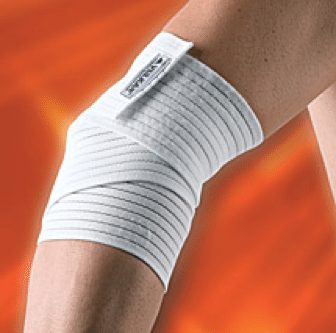 Elbow wrap
Elbow wrap
Sleeves
Sleeves are actually a much better option than wraps because they don’t affect movement mechanics as much but they also provide a type of heat treatment as well.
Sleeves increase the temperature of the body part you put them on which can allow for more pain-free movement plus increased nutrient delivery in and out of the injured cells.
All in all, sleeves are better than wraps but they are still nothing to go crazy about.
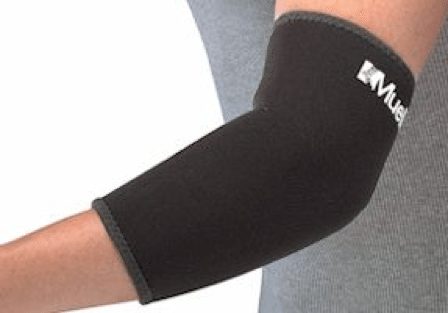 Elbow sleeve
Elbow sleeve
Tape
Tape has worked in some cases although most of the benefit is purely psychological in my opinion. If you want to use it, go ahead, but I don’t generally recommend it just because I don’t believe it to be all that worth it.
If you do use tape (it’s crazy cheap so you can give it a whirl) I’d recommend checking out some YouTube tutorials on how to apply it as it’s crucial that you do this correctly.
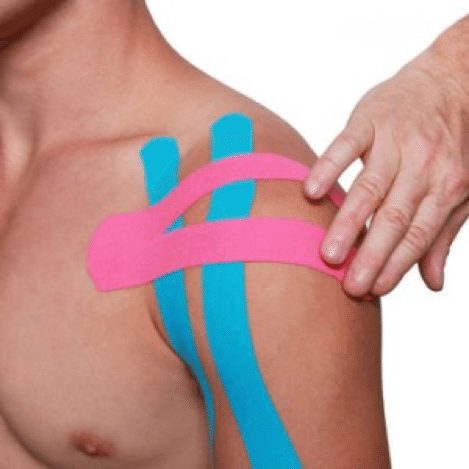 Shoulder tape
Shoulder tape
Braces
Braces are a much more serious approach and one that if your doctor recommends it, he/she means business.
Braces are rigid enough to completely immobilize a joint, much tougher then wraps or sleeves.
They separate themselves from wraps though in the sense that they do not restrict blood flow, which gives them an extra bonus point.
Due to the toughness of braces, they are reserved for more serious sprains (as opposed to just strains that is).
Something that braces also do that no one really thinks about is helping you keep your joint in a safe position while you sleep, something that none of the above other tools will do.
I like braces for the recovery of the more serious stuff.
But at the same time, you have to take the brace off and move around as pain-free range of motion kicks back in again.
Don’t just let it sit there stiff as a board all the time. Getting it moving again (pain-free) is going to accelerate the recovery process faster and more effectively than anything else.
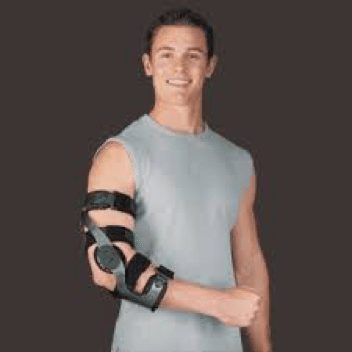 Elbow brace
Elbow brace
Ice vs. Heat
Let’s start out with ice. Why do people use ice?
To slow down inflammation and reduce blood flow.
Just like with NSAIDs, you’re going to hit a point of diminishing returns here and play more into sabotaging your own recovery then you are supporting it.
I have talked before about how ice can be detrimental towards your progress in strength and muscle mass (but there’s a time and place for ice too) so check out my other articles/videos on recovery if you’re interested in that because I want to stay on topic within this article specifically on injuries.
What I’m saying here for ice with respect to injury is only use it if you absolutely have to. If the injury is wildly swelling and inflamed, use it temporarily. If it’s not, don’t use it.
Heat on the other hand speeds up blood flow (so does massage treatment and contrast showers) which is accomplishing the exact opposite of ice. You can actually compare heat treatment to active recovery in a way (moving around to get the blood flow moving) due to its ability to locally enhance circulation.
As far as injuries go in this department:
• Heat is generally good
• Ice is good in severe cases only
• Contrasting hot and cold is generally good
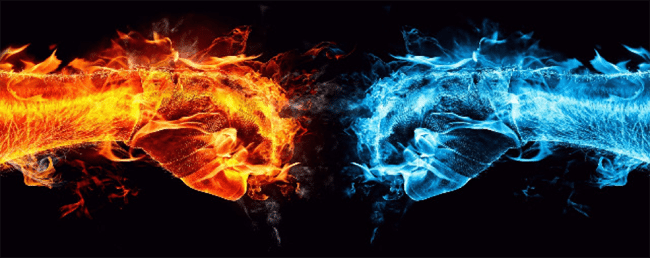 Fire and Ice
Fire and Ice
Stretching
If you want the complete rundown on all things mobility and stretching, make sure you check out my free guide here as it’s the largest online resource of hockey-specific mobility material available today.
From an injury recovery perspective though, stretching is pretty much useless.
There is even much debate about stretching injury prevention ability, many experts posing it does more harm than good in the prevention department as well.
It’s something athletes have done for a long time but science is really starting to shape up how unnecessary it is within this specific context. For example, within injury prevention, simply being strong is light years more important than your current flexibility.
Getting back to injury recovery.
I typically just don’t mention it to athletes.
If they want to stretch, they can.
If not, I don’t care.
It’s neither good nor bad here.
Although it’s worth mentioning that stretching can actually reduce oxygen and blood flow to your muscles, which would therefore negatively affect your recovery process.
If you want to spend more time moving during your injury process, actually move, don’t stretch.
We will discuss the importance of active recovery within Part 2 plus throw in some tips and tricks for training around the most common hockey injuries.
Click here to check out Part 2 of this Hockey Injury Recovery series and learn exactly how you can train around the most common lower and upper body injuries!






